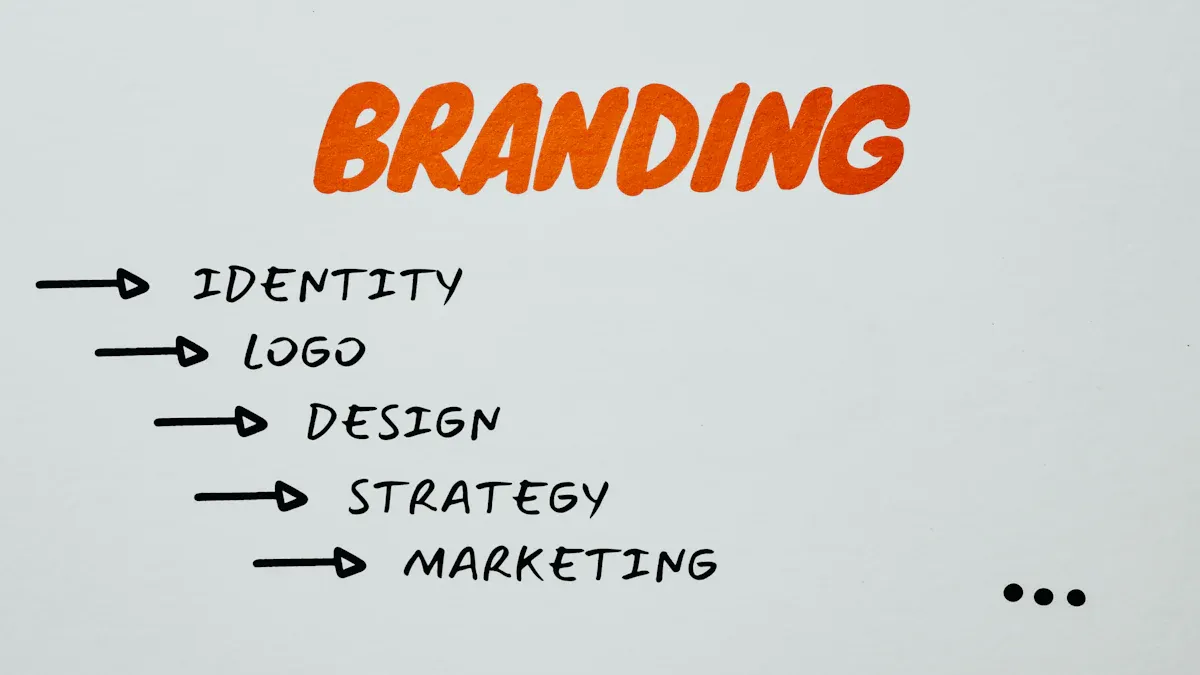
Brand Strategy Template for Growth
Table Of Contents
Why Most Brands Fail Without a Strategy Template

Building a brand without a strategy template is like constructing a house without blueprints – you're setting yourself up for confusion and wasted effort. A brand strategy template provides the structure and direction needed to build a strong, cohesive brand presence. Let's look at why this foundation is essential for success.
A good template transforms abstract branding concepts into concrete action steps. Rather than vague goals like "increase awareness," you get specific, measurable objectives. For example, your template might include a detailed content calendar with target keywords, posting schedules, and engagement metrics.
The Power of Structure: How Templates Drive Success
Let's examine how brand strategy templates improve key performance metrics:
| Metric | Without Template | With Template | Improvement |
|---|---|---|---|
| Brand Consistency | 45% | 89% | +44% |
| Team Alignment | 52% | 94% | +42% |
| Campaign ROI | 1.2x | 2.8x | +133% |
| Time to Market | 12 weeks | 6 weeks | -50% |
A well-crafted template keeps everyone focused on shared goals, much like a conductor guiding an orchestra. When your whole team understands the strategy, you eliminate confusion and work more efficiently.
Real-World Impact: Branding as a Growth Driver
Recent studies highlight just how crucial strong branding is for business growth. According to research from Latana, 77% of B2B marketing leaders view branding as essential for growth. The data also shows B2B customers are twice as likely to choose brands that connect with them on a personal level.
But knowing branding matters isn't enough – you need a practical way to implement your strategy. This is where templates prove invaluable, providing a framework to turn high-level brand concepts into specific tactics and measurable results.
Avoiding Common Pitfalls with a Template
Strong brand templates help companies sidestep typical branding mistakes. They ensure your messaging stays consistent across all channels, building trust with your audience. When everyone follows the same blueprint, you avoid mixed messages that could confuse customers.
Templates also help brands stay nimble and relevant. Regular template reviews let you spot market changes early and adjust your approach accordingly. This built-in flexibility helps maintain strong connections with your target audience even as their needs evolve.
Building Your Brand Strategy Foundation

Creating a strong brand takes careful planning and a solid foundation. Let's explore the key building blocks that come together to form a memorable and effective brand identity.
Defining Your Vision and Mission
Your vision statement is like your brand's guiding star – it describes where you want to go and what impact you aim to make. A clear vision helps inspire both your team and your customers.
Your mission statement captures why your brand exists and how you'll achieve your goals. It outlines what you stand for and gives your team clear direction. Think of it as your brand's purpose and promise all rolled into one.
Understanding Your Target Audience
Getting to know your audience is essential for success. Create detailed buyer personas that capture who your customers are, what they need, and what motivates them. This knowledge shapes everything from your messaging to product development.
For instance, if you're targeting busy parents, you might focus on convenience and time-saving benefits. If you're speaking to tech enthusiasts, you'd highlight innovation and cutting-edge features. You might be interested in: How to master…
Aligning Your Team Around Core Values
Your core values are the principles that guide your brand's behavior and decisions. These values should show up in every interaction – from internal meetings to customer service. If "quality" is a core value, it should be evident in your products, processes and communications.
When your whole team understands and lives these values, it creates consistency in how your brand comes across to the world.
Crafting Consistent Brand Messaging
Your brand needs to sound and feel the same everywhere customers encounter it. Whether someone visits your website, follows you on social media, or talks to your support team, they should get the same impression of who you are and what you stand for.
A brand strategy template can help organize this process. These tools provide worksheets and frameworks for defining your values, messaging and audience targeting. Learn more about brand strategy templates here. Having this structure ensures all pieces of your brand strategy work together smoothly.
Building a Cohesive Brand Identity
When you thoughtfully develop your vision, mission, values and messaging, you create a brand that connects with your audience in a meaningful way. This strong foundation helps you stand out and build real relationships with customers. It also gives you a clear framework as your brand grows and evolves over time.
Crafting Your Unique Value Story

Building a strong brand requires more than just visual elements. The real power lies in creating a compelling value story that connects with your audience on a deeper level. Let's explore how to build a narrative that grabs attention and builds real relationships with customers.
Understanding What Makes People Care
The best value stories speak to basic human needs and emotions. Rather than listing product features, focus on how your offering improves people's lives. For instance, instead of "Our software increases productivity," try "Our software gives you back precious time with your family." This simple change highlights the real human benefit.
Building Your Story Structure
Two proven approaches can help shape your value story. The first is the "Problem-Agitation-Solution" (PAS) method – identify what frustrates your customers, show you understand their pain, then present how you solve it.
The second is the "Star Moment" approach. This means finding that key instance where your product or service creates the biggest positive impact. Bringing this moment to life helps people connect emotionally with your brand.
Making Your Message Better Over Time
Your value story should grow and change as your business does. The best way to improve it is through real feedback from your target audience. Run surveys, talk to customers directly, and test different versions of your message on your website. This helps you learn what truly matters to people.
Looking at Results
The true test of your value story is whether it drives real business results. Research shows that when customers feel strongly connected to a brand, they spend 23% more on average than other customers. You can read more about brand impact in this Canva guide to brand strategy.
Exercises to Build Your Story
Here are some practical ways to develop your narrative:
- Talk to Customers: Review notes from customer conversations to spot common themes and pain points
- Study Competitors: Look at how similar businesses tell their story and find ways to stand out
- Find Your Character: Consider which classic brand personality (Hero, Explorer, Sage, etc.) fits your company's values
Keep working on your value story consistently. A strong narrative that evolves with your business will help drive long-term success and growth.
From Strategy to Reality: Implementation Guide

Having a solid brand strategy is just the first step. The real challenge lies in turning those plans into concrete actions. Let's explore how to move from ideas to actual results.
Creating an Actionable Timeline
Breaking down your strategy into clear, manageable phases helps your team stay focused and on track. Think of it like building a house – you need a foundation before you can add walls and a roof.
Start with internal alignment, then move on to updating materials, and finally launch your external campaign. Having these distinct milestones makes the process feel more achievable and keeps everyone moving in the same direction.
Managing Stakeholder Expectations
Good communication is essential for successful implementation. Keep your team leaders, marketing staff, and customer service representatives in the loop about changes and progress. When people understand their role in the bigger picture, they're more likely to support the strategy.
Be open about challenges that come up along the way. Brand strategies need room to grow and adapt based on real-world feedback. Involving stakeholders in these discussions builds trust and maintains momentum.
Measuring Progress and Making Adjustments
Set up clear key performance indicators (KPIs) to track how well your strategy is working. Common metrics include:
- Website traffic numbers
- Social media engagement rates
- Customer satisfaction scores
Review these metrics regularly to spot what's working and what needs tweaking. Your brand strategy should evolve based on real data and customer feedback.
Implementation Timeline Example
Below is a practical breakdown of how to roll out your brand strategy:
| Phase | Duration | Key Activities | Expected Outcomes |
|---|---|---|---|
| Phase 1: Internal Alignment | 2 weeks | Share new brand values with staff; Run training workshops | Teams understand and support new direction |
| Phase 2: Marketing Material Updates | 4 weeks | Update website content, social channels, and marketing materials | All brand messaging matches new strategy |
| Phase 3: Brand Campaign Launch | 6 weeks | Create and run targeted marketing efforts | More brand recognition and customer interest |
Tools and Resources for Implementation
Several practical tools can help manage your brand rollout. Asana or Trello keep projects organized and on schedule. Frontify helps maintain brand consistency. Simple checklists ensure you don't miss important steps.
Remember that your brand strategy is meant to grow with your business. By watching the data and listening to feedback, you'll keep your brand strong and meaningful to customers.
Measuring What Matters in Brand Success
Strong brands are built on much more than visual elements. To grow a brand effectively, companies need to focus on the metrics that provide real value. Let's explore the key measurements that help brands make smarter decisions and achieve meaningful growth.
Focus on Metrics That Drive Action
While social followers and website traffic provide basic visibility, the deeper story comes from measures like brand equity, audience relationships, and competitive position. These metrics reveal how people actually connect with and value your brand.
Customer lifetime value tells you far more about financial health than short-term sales spikes. Similarly, using social listening tools and surveys to track brand sentiment shows how your audience genuinely feels about your company.
Measuring the True Value of Your Brand
Your brand's value includes both concrete assets like trademarks and intangible ones like customer loyalty. Brand valuation helps assign real numbers to these elements. Regular measurement of brand awareness, recognition, and recall through surveys and focus groups shows if people know and remember you.
Building Real Connections with Your Audience
Meaningful audience relationships go far beyond surface-level attention. Track metrics like content engagement, time spent on site, and email response rates to see how well you're connecting. But don't stop there – gather direct feedback through surveys and reviews to understand what your audience truly needs.
Understanding Your Market Position
Knowing exactly where you stand helps you make smart choices. Study your market share, analyze competitors, and run brand perception studies to map out your position clearly. Watch for shifts in market share that may signal changing customer preferences.
Look closely at what makes your brand different from competitors. Understanding their approaches can help you find ways to stand out. You might be interested in: Learn more about design site maps.
Creating Your Measurement System
Build a brand tracking template that combines hard numbers with customer feedback for a complete view. Include key metrics like awareness, satisfaction scores, and market position. Update it regularly as your brand and market evolve.
Set up a dashboard to monitor your most important metrics in one place. This makes it easy to spot both wins and areas needing work. Regular analysis helps you make choices based on real data rather than guesswork.
Navigating Common Brand Strategy Challenges
Building a strong brand takes continuous effort and refinement. Many businesses face common obstacles along the way. Let's explore these challenges and practical ways to overcome them.
Maintaining Brand Consistency Across Channels
Creating a unified brand experience is one of the biggest tests organizations face. Your brand needs to feel consistent whether customers interact through your website, social media, or in-person service. This means keeping your messaging, visuals, and voice aligned across all touchpoints. For instance, if you project a casual, friendly tone on Instagram, maintaining that same approachability in your email communications builds trust.
Managing Stakeholder Expectations
Different teams often have competing ideas about brand direction. Marketing, sales, and leadership may pull in different directions, leading to mixed messages. The solution is clear communication and early involvement of key players in strategy development. When everyone contributes to and understands the vision, alignment follows naturally. Learn more about effective brand management in our guide on How to master….
Adapting to Market Changes
Customer preferences and market conditions shift constantly. What worked last year might not resonate today. Regular monitoring of key metrics like website analytics, social engagement, and customer feedback helps you spot emerging trends early. Be ready to refresh your messaging, update visuals, or adjust your audience focus as needed.
Overcoming Internal Resistance
Sometimes the biggest hurdle comes from within – team members may resist brand changes or cling to old approaches. The key is helping everyone understand the "why" behind new initiatives. When employees feel heard and see the benefits clearly, they're more likely to embrace changes with enthusiasm.
Maintaining Authenticity During Growth
As companies expand, staying true to core values becomes harder. Rather than chasing every trend or trying to please everyone, focus on what makes your brand unique. Regularly review your brand strategy to ensure it still reflects your mission. Authentic brands stand out naturally in crowded markets.
Building Lasting Brand Equity
Creating real brand value takes time and consistent effort. Brand equity means customers willingly pay more for your offerings versus generic alternatives. Build this through excellent products, outstanding service, and clear, consistent messaging that reinforces your brand promise.
Understanding these common challenges helps you develop a resilient brand strategy. With proactive planning and regular refinement, your brand can thrive even as markets evolve.
Ready to strengthen your brand? LaunchBox offers complete design services – from brand development to web design, packaging and animation – all focused on helping businesses grow. Visit LaunchBox to learn how we can bring your brand vision to life.
Article created using Outrank








